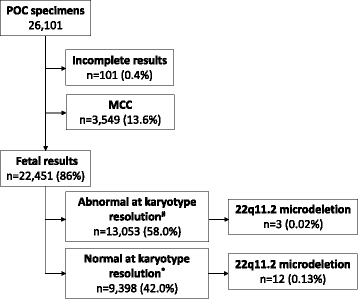Incidence of the 22q11.2 deletion in a large cohort of miscarriage samples
- PMID: 28293297
- PMCID: PMC5345148
- DOI: 10.1186/s13039-017-0308-6
Incidence of the 22q11.2 deletion in a large cohort of miscarriage samples
Abstract
Background: The 22q11.2 deletion syndrome is the most common microdeletion syndrome in livebirths, but data regarding its incidence in other populations is limited and also include ascertainment bias. This study was designed to determine the incidence of the 22q11.2 deletion in miscarriage samples sent for clinical molecular cytogenetic testing.
Results: Twenty-six thousand one hundred one fresh product of conception (POC) samples were sent to a CLIA- certified, CAP-accredited laboratory from April 2010--May 2016 for molecular cytogenetic miscarriage testing using a single-nucleotide polymorphism (SNP)-based microarray platform. A retrospective review determined the incidence of the 22q11.2 deletion in this sample set. Fetal results were obtained in 22,451 (86%) cases, of which, 15 (0.07%) had a microdeletion in the 22q11.2 region (incidence, 1/1497). Of those, 12 (80%) cases were found in samples that were normal at the resolution of traditional karyotyping (i.e., had no chromosome abnormalities above 10 Mb in size) and three (20%) cases had additional findings (Trisomy 15, Trisomy 16, XXY). Ten (67%) cases with a 22q11.2 deletion had the common ~3 Mb deletion; the remaining 5 cases had deletions ranging in size from 0.65 to 1.5 Mb. A majority (12/15) of cases had a deletion on the maternally inherited chromosome. No significant relationship between maternal age and presence of a fetal 22q11.2 deletion was observed.
Conclusions: The observed incidence of 1/1497 for the 22q11.2 deletion in miscarriage samples is higher than the reported general population prevalence (1/4000-1/6000). Further research is needed to determine whether the 22q11.2 deletion is a causal factor for miscarriage.
Keywords: 22q11.2 deletion; Bioinformatics; Miscarriage; Products of conception; Single nucleotide polymorphism (SNP) microarray.
Figures


References
-
- McDonald-McGinn DM, Emanuel BS, Zackai EH. 22q11.2 Deletion Syndrome. 1999 Sep 23 [Updated 2013Feb 28]. In: Pagon RA, Adam MP, Ardinger HH, et al., editors. GeneReviews® [Internet]. Seattle: University of Washington, Seattle; 1993-2017. - PubMed
-
- Botto LD, May K, Fernhoff PM, Correa A, Coleman K, Rasmussen SA, Merritt RK, O'Leary LA, Wong LY, Elixson EM, et al. A population-based study of the 22q11.2 deletion: phenotype, incidence, and contribution to major birth defects in the population. Pediatrics. 2003;112:101–7. doi: 10.1542/peds.112.1.101. - DOI - PubMed
Publication types
LinkOut - more resources
Full Text Sources
Other Literature Sources
Miscellaneous

